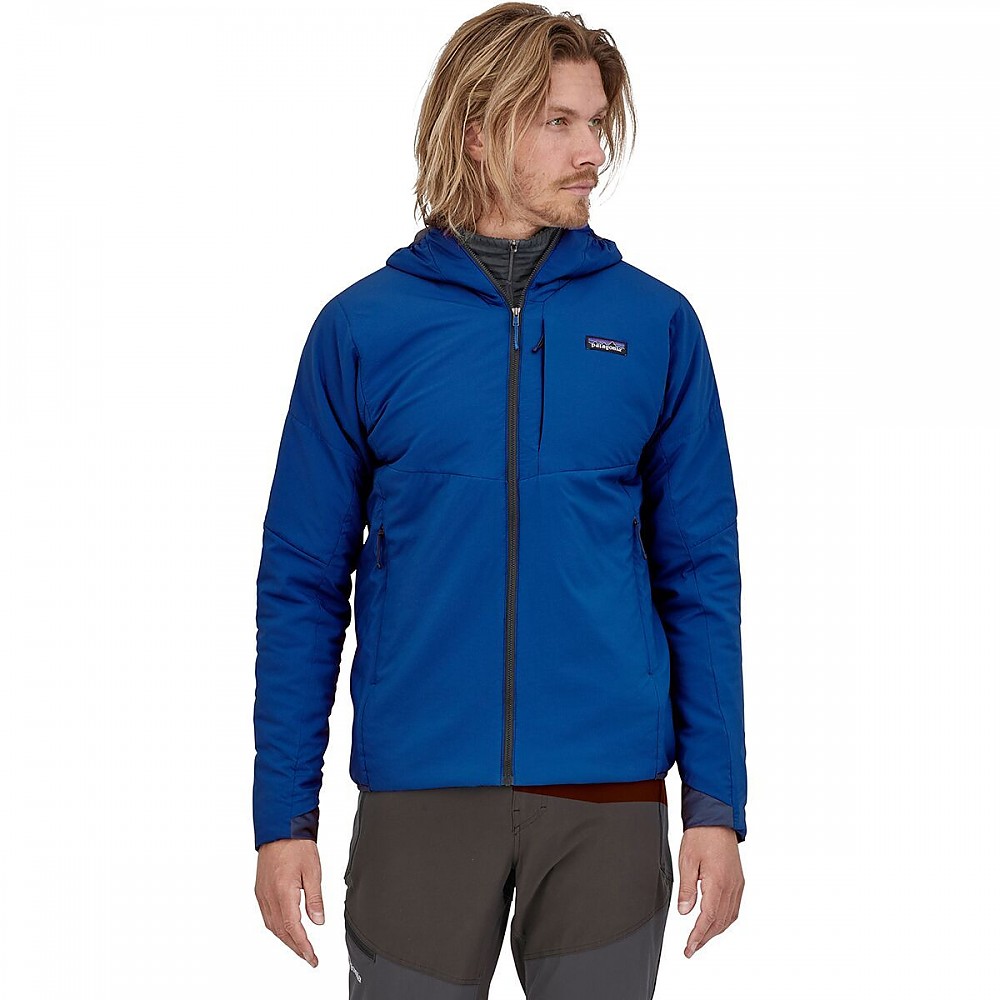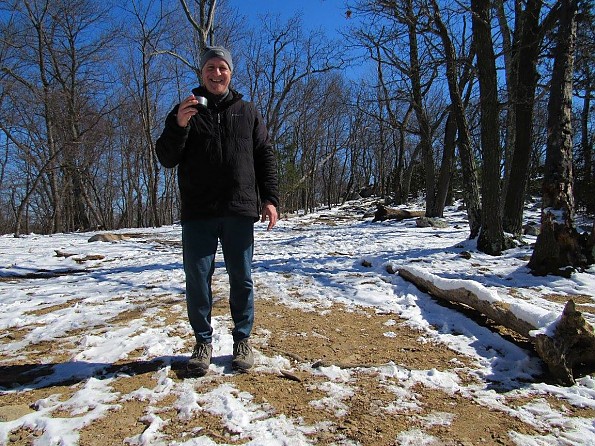Patagonia Men's Nano-Air Hoody

The Nano-Air Hoody is a mid-weight insulating layer than can reach across a wider than normal range of temperature and weather conditions. It is relatively unusual in that the synthetic insulation is encased in a soft, stretchy nylon shell that is more stretchy and much more permeable to air than a typical soft shell. Its ability to wick moisture away and "wear dry" quickly is exceptional for a layer with its insulting properties.
Weaknesses include somewhat shapeless pockets that sag when filled and sizing that, like a number of Patagonia garments, can be a bit peculiar.
Pros
- Versatility
- Moisture handling
- Comfort
Cons
- Sizing
- Pockets sag
- Price
This review follows a year wearing the Nano Air Hoody a lot. I'm outside a lot, typically walk or hike 500-600 miles a year in all kinds of weather. It isn't perfect, and it's quite expensive. It's a great jacket to wear when you're active, working hard in cooler to cold weather, because its combination of insulating properties, air and moisture wicking, and quick-dry capabilities work in such a wide range of temperature and wind conditions. also great for sitting around on cool three-season evenings.
Basic Details
The Nano Air Hoody cost nearly $250 new. It is a full front zip jacket with four pockets, all in the front. Two smallish chest pockets and two lower, larger 'hand' pockets. All zippers run smoothly and have zipper pulls that are pretty easy to use with gloves. The pretty thin and stretchy fabric means items of any weight will make the pockets sag. Unexpected, not a deal-breaker, but it feels weird that something as light as my smart phone makes the pocket sag so much.
The hem has a shock cord that can be pulled tight on both sides. The cuffs and edge of the hood are elastic but don't adjust. In fact, there is no hood adjustment at all. My size XXL weighs 15-16 ounces.
The Fabric and What It Does
I wish that I had a cross-section of the insulation for this jacket. It consists of thin pieces of synthetic insulation that are sewn to an inner and outer nylon shell, though calling it a 'shell' really doesn't describe it well. By 'thin,' i mean at most as thick as a Patagonia R3 or 300 weight Polartec fleece jacket. It's not 'fill' the way you would think of a down or Primaloft puffy jacket. My best guess/estimate is that it looks sort of like Primaloft, but it is manufactured as flat pieces more akin to Polartec fleece, and that best describes how it functions.
The inner and outer shell is stretchy nylon. Pretty thin, very stretchy, offering not much more wind resistance than a Polartec fleece jacket. The insulation is stitched to the outer nylon layer; the inner nylon layer is about the same weight and consistency. It is lighter and stretchier than virtually all other soft shells I have worn. The photo of the pocket detail above shows how it is stitched together.
Worn alone as an outer jacket, it is great in cool (mid-low 60s is as warm as I have tried it) to cold (teens and twenties) weather, so long as you're active and the wind isn't blowing too hard. In increasingly cold and windy weather, you'll lose a lot of core temperature because it doesn't stop wind much. But, I can wear this jacket on steep uphills carrying a large pack without worrying much that I'll overheat because air flows through it so easily and moisture wicks away about as well as a fleece. The fabric may have a very light DWR, but precip pretty quickly soaks in. if you wear this in the rain, freezing rain or wet snow, you'll probably need a hard shell over it.
As a mid-layer under a shell, the jacket is much warmer, again made for being out and active. It doesn't offer enough insulating/dead air space to sit around in cold weather for long periods of time; it's ideal for windy cold weather hikes under a shell.
Being able to wear the same jacket from cool fall days all the way through winter hikes under a shell is the real highlight and advantage of this jacket. I don't have anything else like it in my closet in that respect.
Fit/Comfort
One of my occasional peeves about Patagonia is in the way their garments sometimes have odd issues with how they fit. My level of angst about this jacket is low to medium. I wear a size 46 jacket, which almost always means I buy an extra large. With the Nano Air Hoody, the shoulder area felt sufficiently constricted that I opted for size XXL. But, the sleeves of the XXL are a little long, and the body of the XXL other than the shoulders is a little looser than I would like. Fit is the reason I grade it four stars rather than five.
The elastic, non-adjustable cuffs do the job well—Patagonia has clearly nailed this. The hood is on the loose side, and worn without any hat, it sometimes droops and partially obscures my vision. It's definitely a hood better worn with a wicking ball cap on the warmer side and a mid-weight knit or fleece hat in colder weather, because adding a brim or even a bit of volume makes the hood fit much better.
The very stretchy material means this won't impede your movement at all, unless you size it too small. The inner fabric feels great next to my skin, even if I'm wearing a short sleeved T underneath. This is a quiet jacket, doesn't rustle in the wind at all.
Function in the Field
Rather than summarize, I'll include some observations I made along the way on specific days.
1. Cool weather hike on the Billy Goat Trail near my house in Maryland. It's a fall day, mid-fifties, northwest winds 10-20. The trail can be taxing, it's a sweat inducing couple of hours out and back. I wore the Nano Air Hoody with a mid-weight merino short sleeved T and shorts. When I was working harder, I half unzipped the front. I was sweating, always do on that trail no matter the season, but not drenched and pretty comfortable. I kept the jacket on when I stopped for a snack. The jacket was a little damp afterward. Very happy with it today.
2. Cold winter walk. Wearing a Patagonia RI grid fleece long sleeve shirt and a knit wool cap, long john bottoms. Out for a couple of hours at the end of the day. It's in the mid-twenties, windy, some snow flurries falling. I'm a little cold at the outset due to the wind — it's cutting through this jacket. As I get moving and work the trekking poles hard on the first uphill, the wind isn't bothering me as much, and I'm pretty psyched that I'm not overheating. I wore the hood most of the time and was happy with it.
3. February hike up Sugarloaf, about a half hour from our house, with my 15-year-old (she's 16 now). Mid-20s, sunny, light wind. I'm wearing a fleece beanie and a mid-weight merino long sleeve layer underneath, shell pants over a very light long john. We meandered around lower parts of this small mountain to add a little mileage then hit the short, steep top section that is always pretty hard work. I have about 20 pounds on my back. A fair bit of rime forms on the outside of the jacket as moisture wicks out and freezes. I kept the jacket on at the top, didn't need to pull on an outer shell while we shared some hot chocolate and snapped a few pictures.
4. Cool summer evening in Maine, wore it to an outdoor restaurant with a golf shirt underneath. Fine sitting around as things cool off. The jacket tends to pick up odors and smells like the restaurant after. I wash this after any hard, sweaty hike because it doesn't smell great otherwise; wash it on delicate, low agitation, and I partially dry it (low heat, maybe 20 minutes), remove it damp, and let it dry the rest of the way on a hanger.
5. Late fall hike in the Shenandoah — a bigger, longer hike, Old Rag, one of the family favorites. A couple of hours away. Same wool T I wore in mid-50s weather. On the uphills, which are pretty hard, I'm half-unzipped. At the top, I added a light synthetic long-sleeved layer when we stopped, then pulled a shell on over everything as it turns out to be fairly windy.
6. Walk along the main artery near our house and over to the Seven Locks tTrail during a snowstorm. Crummy wet snow with some ice underneath, I'm wearing MicroSpikes on my boots and a thin long sleeve synthetic shirt under the Nano Air. I'm not wearing a shell, seeing how it handles wet snow. I'm fine during the walk — core temperature well-regulated — and the jacket still keeps me plenty warm, wore the hood on and off to avoid overheating. It's getting damp as I go, I can feel it's somewhat heavier. Wet stuff intrudes pretty quickly. 

Durability
No damage or product failures after a year. Not my choice for bushwhacking; I think the outer fabric would tend to snag pretty easily. Typical quality Patagonia construction.
Conclusions
I really like the jacket. There are so many days where this is what I reach for and what I wear all day. The fit could (and hopefully will) get nailed down so it's true to size, and the saggy pockets are a pretty inevitable consequence of the outer fabric choice, which exists for pretty easy-to-understand reasons.
Source: bought it new
Price Paid: $249
This has become my go-to layer for anything aerobic: from hiking and ski-touring, to simply walking and city living. Very warm for its weight, and breathes super well.
Pros
- Lightweight
- 4 pockets
- Weather resistant
- Nicely fitted hood
- Soft elastic cuffs
- Ultimate breathability
Cons
- So thin and lightweight I feel I need to be careful with it
After years of using a variety of fleece and down hoodies, I have found my new go-to hoodie for everything active. It's super lightweight, way warmer than I thought it could be (I now regularly wear just a t-shirt underneath for ski touring, rather than a long-sleeve base layer), DWR does well in an hour or two of light rain, fairly wind resistant, compact, and it fits great.
Hood is not made for helmets, which is fine as I use it for X-C and backcountry skiing and hiking, and although there's no cinch-strap, it fits extremely well.
I normally don't like elastic cuffs, but these are so comfy!
Breathability is amazing as well. Plus, I've worn it and sweated in it every weekend for two months, haven't washed it once, and it still smells new!
Not the cheapest hoodie out there, but if you're looking for something that works so we'll is so many different conditions and for so many different activities, this is your hoodie!
Source: bought it new
Price Paid: $275
![]() All Nano-Air Hoody versions
All Nano-Air Hoody versions
In addition to the 2 men's reviews above, there are 2 reviews for other versions of the Nano-Air Hoody. Read all reviews »
Your Review
Where to Buy
You May Like
Specs
| Price |
MSRP: $299.00 Current Retail: $229.99-$329.00 Historic Range: $124.50-$329.00 Reviewers Paid: $249.00-$275.00 |
| Weight |
346 g / 12.2 oz |
| Insulation |
60-g FullRange 100% polyester (40% recycled) with four-way stretch |
|
Fabric is certified as bluesign approved |





